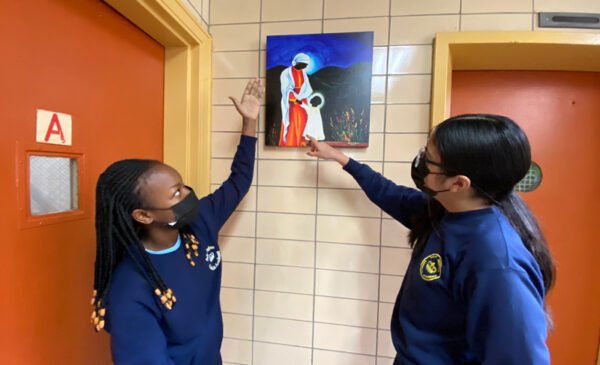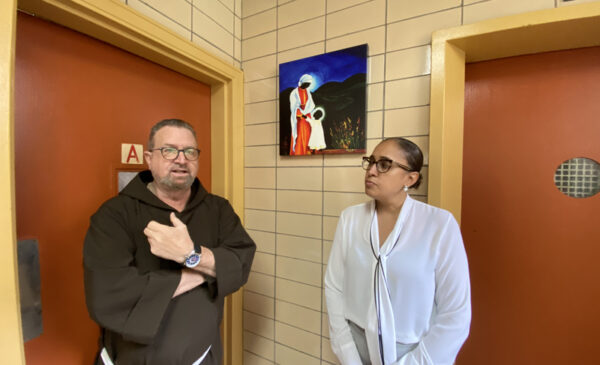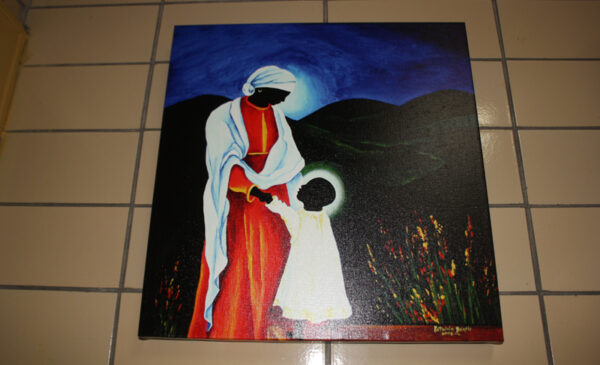‘Representation matters in all aspects of life’
EAST NEW YORK — A mystery persists at Salve Regina Catholic Academy, part of St. Michael-St. Malachy Parish. There, a few years ago, a student challenged the pastor with a decidedly pointed question.
“I stepped into a classroom,” recalled Father Brendan Buckley. “And I don’t remember what I was doing … but there was a young, African American student, and this young man said to me, ‘How come every image of Jesus, He’s white?’ ”
Neither Father Buckley nor Principal Michelle Donato could recall the student’s name, although they’re still trying to solve that mystery.
Diverse Cultures
In response to the student’s challenge to the priest back in 2018, Father Buckley purchased several pieces of artwork depicting religious images from diverse cultures. They now hang in the school’s corridors.
“That awakened in me a thought, ‘I need to do something here,’“ he said, “because these young men and women need to see something that involves how the Gospel comes alive within their culture.”
Father Buckley explained how the art reflects the culture of East New York, a neighborhood filled with people of various races — the largest population being African American at 63 percent, according to the U.S. Census.
“This is a reflection of our Catholic faith right here in the school building,” Father Buckley said. “We do have some Asian people here. And there are students here whose families are from Africa — Nigeria and other countries. And we have Puerto Rican, Dominican, Ecuadorian, and Mexican families.”
The collection includes “The Resurrection and the Life” — an image of Jesus as an African American with dreadlocks, by artist Raymond Walker. Here, the Savior extends his hands, pierced by the crucifixion for the salvation of all.
This year, in time for November as Black Catholic History Month, the school acquired “Ethnic Last Supper” by William Ternay. It’s similar to Leonardo da Vinci’s “The Last Supper,” although all those around the table, including Jesus, are people of color.
Others depict historical events, such as Rev. Martin Luther King Jr. leading the March on Washington and abolitionist Harriet Tubman helping slaves achieve freedom via the Underground Railroad.
A painting from Venezuela is a Latino interpretation of the suffering of Jesus in the crucifixion.
Another popular image — “Madonna and Child First Steps” — is by Patricia Brintle, a Queens-based artist who also founded a non-profit that helps rebuild churches in her native Haiti.
Father Buckley said he did not know about Brintle’s group, “From Here to Haiti,” when he found the painting online. Still, he knew he had to buy it for the school because of the tenderness it projects — a Haitian woman and her son surrounded by wildflowers and standing in the light of the moon rising over mountains. The child, however, has his own halo.
“You can feel the love between that mother and her child, and I think that’s why I love it,” Principal Donato said. “Yeah, it’s my favorite. And I get to see it every day.”
So do the students.
Jameeah Lawal, who is in the sixth grade, and Amanda Fernandez, an eighth-grader, lingered in the hallway outside the principal’s office, marveling at “Madonna and Child First Steps.” They also remarked about the picture’s poignancy and its vibrant colors.
“I think it’s really important to see images of dark-skinned saints and dark-skinned Jesus,” said 11-year-old Jameeah. “It makes you feel more included. And it makes me more confident in my faith.”
Amanda, 13, said, “I feel like sometimes people see faith as only one way. But there are different ways of seeing it through cultures and different ethnicities. I’m proud that our school represents different cultures and different races when it comes to faith.”
Brennan Elder, 13, also in the eighth grade, said he appreciated “The Resurrection and the Life” for its bold colors “that really pop,” as well as the Rastafarian-influenced depiction of Jesus.
He said the school’s art collection appropriately represents multiple cultures.
“If an Asian person would see only a white Mary, they may feel like they are not being represented,” Elder said. “They might feel they are not as important. That needs to change.”
He continued, “In this time and era that we live in, diversity is very important. Representation matters in all aspects of life.”
Father Alonzo Cox, coordinator for the Vicariate of Black Catholic Concerns in the Diocese of Brooklyn, applauded the school’s art collection and the efforts to acquire it. Father Cox is also pastor of St. Martin de Porres Parish, Bedford-Stuyvesant.
“Father Brendan asked me to stop and take a look at some of the paintings,” Father Cox said during a visit to Salve Regina. “He told me this wonderful story of this kid who said, ‘Why don’t images in the Church look like me?’ And I hear that so much.
“There are still communities, particularly African Americans, who are longing to see images that look like them,” Father Cox continued. ”So I think this is a wonderful idea, especially during National Black Catholic History Month here in November.”
Father Buckley said he acquired the artwork with parish funds.
“The Gospel is in every nation,” he said, “and every nation gives birth to its own art. Our Catholic faith is reflected in the art of people from very different cultures.”
Today, he added, gathering art that reflects various cultures seems like a “no-brainer.” But, back in 2018, it did not occur to him until the student “asked the question.”
Father Buckley said he returned to the classroom and asked who knew of the student posing the question, and none responded. He conferred with staff members, who likewise could not trace the thought-provoking inquiry.
But that student, who would now be in high school, still receives gratitude from the pastor, his former principal, and the community of students who came after him.
“He’s out there,” Father Buckley said, “and he did a great service. I would say to him, ‘Thank you for asking the right question and prompting us to reflect on what was important to you and to this community.’”
Donato also praised the student for his question and the artistic and spiritual legacy it created.
She asserted, “I would say to him, ‘Look at what that simple question created. So, we are grateful to you.’“




